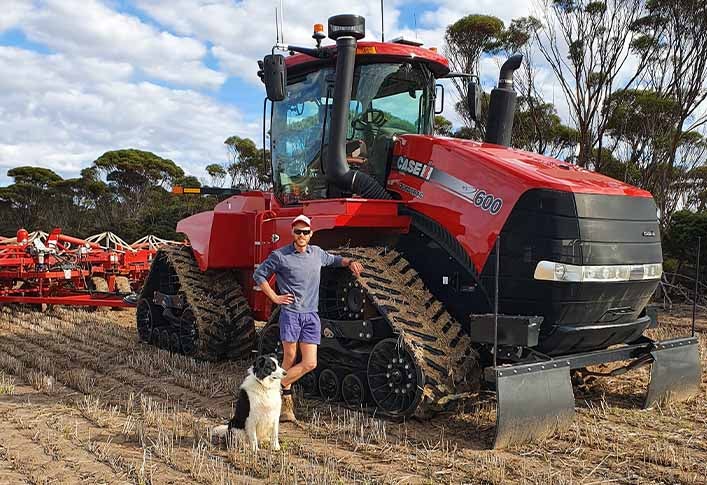Posted by on
16/03/2022
The recent escalation in fertiliser prices made for confronting budgets leading into the winter cropping season, but for one Western Australian producer, an investment in precision technology is ensuring every dollar spent on inputs counts.
Esperance grain grower John Sanderson, who farms 6,000 hectares together with his parents Danny and Judy plus wife Desiree, has long relied on soil mapping and sampling for the most accurate indication of soil nutrition and believes it’s technology that will certainly prove its worth this year.
With their soil nutrient levels potentially lower off the back of a bumper crop in 2021, coupled with the significant increase in input costs, he said the stakes were high this season – but he had confidence that data gained from soil sampling was an extremely valuable tool when setting input rates and reducing costs.
“Having evidence based data we can use to really optimise our fertiliser usage is going to be a huge benefit this year. After rebates it’s only a couple of thousand dollars to have our soils sampled, which is money very well spent.”
Data driven efficiency
John and Danny work closely with their agronomist Luke Marquis of South East Agronomy Services, who is a firm believer in the old adage, ‘you have to measure it to manage it’.
“In past years when input prices were low, we were all a bit flippant when it came to managing our applications of Nitrogen, but this year calls for analytical and strategic, informed decision-making,” Luke said.
Luke and the Sandersons worked with CSBP’s soil analysis labs and NUlogic models to produce detailed nutrient demand recommendations, as well as satellite imagery demonstrating each individual paddock’s range of yield potential, and the application rate of nutrients necessary to achieve those yields.
“Soil mapping and subsequent strategic testing ensures we can identify what each paddock needs to reach our budgeted yield, without overcapitalising or undercapitalising,” Luke explained.
Last year’s wheat crop averaged three to 3.5 tonnes across all farms, and at this stage the Sanderson’s budget on growing a smaller crop averaging a 2.5 tonne yield – which is their long-term average.
“The beauty of soil sampling is that we can analyse exactly what inputs need to be applied to maintain soil nutrient levels after last year’s massive crop, and we can really drill down on the rates required to chase that 2.5 tonne yield,” John said.
It’s data that enables a redeployment of capital to ensure the balance of inputs is correct to reach yield potential, reflecting significant efficiency gains.
Last year the Sandersons applied an average of 70kg/ha of Agflow trace, around 12.6 units of Phosphate. This year, after utilizing data from soil sampling, they cut that rate to around 50kg/ha of Agflow or nine units of Phosphate.
“This won’t be enough to build the bank of Phosphate in the soil, but will be a maintenance level and enough to grow an average yield,” John explained.
The savings from this decision were put into increasing the UAN rate from 70L/ha to 100L/ha – with their data suggesting that Nitrogen rates have a closer correlation to yield year-on-year in their particular area, compared to Phosphate.
‘’We normally band most of our Nitrate up front, and plan for a small top up post emergence. This year, with the price of UAN, we banded the whole lot up front for an average yield, diminishing the risk of loss of efficiency due to volatilization,” John said.
“With Phosphate we normally plan for a maintenance plus building rate, building that Phosphate bank in the soil for tight years such as this.”
“Obviously this year with the prices where they are we will look to go just with maintenance, and if the year turns out better than expected we will rely on the soil bank to provide the remainder of the Phosphate.’’
A two-pronged approach
The value in accessing soil data to customise rates, John believed, was two-fold.
“Last year’s crop was terrific from the start and with rain bolstering growth through June and July, I really questioned whether we had applied enough nitrogen. My gut told me it needed more support, and we needed to seek additional capital to reach that yield potential.”
“After analysing the soil sample and tissue test data we were able to come up with a pretty precise UAN rate, and for the first time apply some of it variable rate.”
As well as saving on unnecessary applications, soil sampling helps the Sanderson’s to achieve their budgeted yields and grow a high value crop.
Luke agreed, and said growers couldn’t afford to begin their season cutting inputs, which would ultimately inhibiting crop potential and yields.
“To just straight out cut rates without any understanding of the science greatly risks production, early vigour is key to achieving budgeted yields.”
Though the Sandersons follow a strict rotation system, they are flexible when it comes to gross margins on a tight budget year.
“We like to stick to regimented rotations, it’s a long game and our paddocks benefit from Luke’s advice, so we try to minimize changing our cropping plan based on market changes or fertiliser prices,” he said. “Summer rainfall will sway the hectares of Legumes, Canola or Barley based on gross margins, but otherwise we stick to our plan.”

Maintaining profits amid escalating growing costs
John is currently reassessing whether more fertiliser was necessary and admitted the prospect of a deficit budget was an enormous worry, just one season on from his best year ever.
“The current input costs have the potential to take all the cream from last year’s crop, so we have to be confident that every dollar spent is towards making a profit.”
The purchase of an inter-regional property in 2020 has further necessitated the Sandersons’ strategic approach to input planning and budget management – soil sampling helping them understand how their new farm, in a different region, will perform.
“We recently engaged VRT Solutions, a precision ag company, to do a full farm survey on the new property, including electromagnetic and gamma radiometric surveys to characterise the soils for their structure, so we will better understand the soil constraints” John said. “It’s an investment that will pay off long term,” John said.
With a large variance in soils across their two operations – their existing farms in the Grass Patch region and their new farm in the Varley district – soil mapping has also helping to identify areas suffering from soil acidity issues on their new property.
This mapping allows them to further increase input efficiency and driving down costs.
